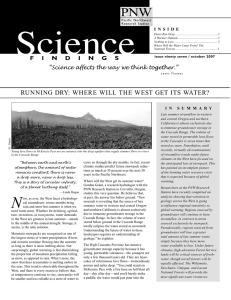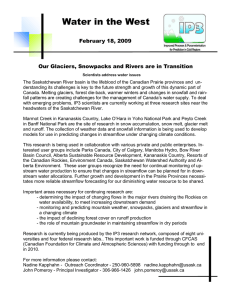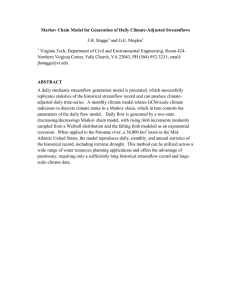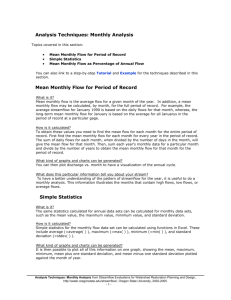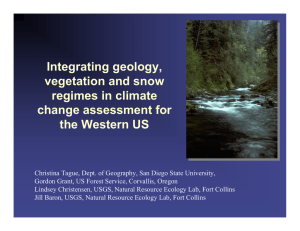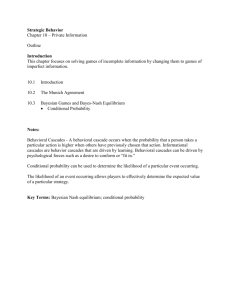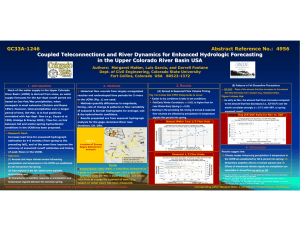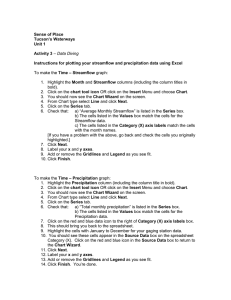Streamflow response to climate warming in mountain regions: Integrating the
advertisement
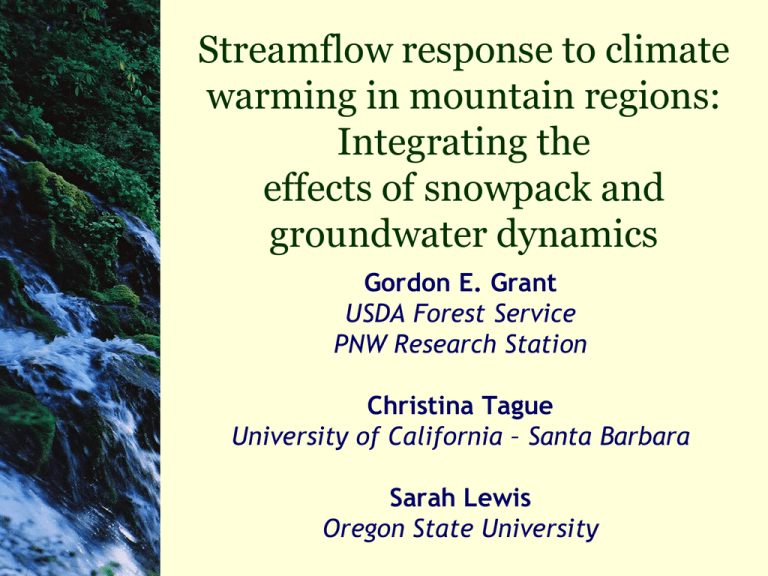
Streamflow response to climate warming in mountain regions: Integrating the effects of snowpack and groundwater dynamics Gordon E. Grant USDA Forest Service PNW Research Station Christina Tague University of California – Santa Barbara Sarah Lewis Oregon State University Historic linear trends in April 1 Snow Water Equivalent a. Observed 1950-2000 b. Modeled Snowpacks have gotten smaller, are melting earlier… Mote et al., 2005 …and are projected to continue to diminish. Montana Washington Idaho Oregon Red = rain instead of snow in the winter “At-risk” snow in a warmer climate: 22% 12% 61% <3% Oregon Cascades Washington Cascades Olympic Range Pacific Northwest study area Nolin and Daly (2006) Historical Trends from Cascade Streams Temporal centroid of hydrograph Autumn minimum discharge 100 Temporal Centroid (Tc) Between 1948 and 2006: Temporal centroid - 14 days earlier Autumn minimum discharge - 1.4 cms lower 3 Discharge (m /s) 150 50 0 10/1/01 12/1/01 2/1/02 4/1/02 6/1/02 8/1/02 10/1/02 Jefferson (2006) But…. • It’s not just about snow…. • Location (geology) matters too… • Major implications for where, when, and how much water will be available in the future – and what its quality will be. High Cascades Western Cascades (surface flow) Western Cascades Will a me tte R iver Cl ac ka m Precipitation and snowmelt run off hillslopes directly and rapidly to stream channels. as N. Santiam S.Santiam High Cascades (spring-fed) McKenzie Precipitation infiltrates into young lava flows and emerges much later at large springs. 2 Unit Discharge (cms/km ) 12 9 6 3 0 10/1 12/1 2/1 4/1 6/1 8/1 Tague & Grant, 2009 Simple Conceptual Model - Linear Reservoir Qt – streamflow at time t (in days) Qo – streamflow at beginning of recession k – baseflow recession constant Q(t ) = Qo e ( − kt ) (Tague & Grant, 2009) pk15-day k tr Treating recharge as a single event, we develop a model for summer baseflow: −k (t r ) r l 5−day Q = pk e Qr – summer streamflow k - drainage efficiency tr - days between snowmelt (tpk) and time of interest (tsummer) pk15-day- snowmelt input (peak reduction in a watershed areal mean of a 15 day running average (Tague & Grant, 2009) Summer flow sensitivity to changes in snowmelt dynamics (first derivatives) ∂Qr − k (t r ) Magnitude =e (pk15-day) ∂ pk15day ( Timing (tr) ) ∂Qr −k (t = pk15day ∗ ke ∂ (t r ) r ) Both contain k, drainage efficiency (Tague & Grant, 2009) Magnitude sensitive unit change in daily streamflow (mm/day) long short Not sensitive deep/slow shallow/fast (Tague & Grant, 2009) Timing sensitive unit change in daily streamflow (mm/day) long short Not sensitive deep/slow shallow/fast (Tague & Grant, 2009) RHESSys Original framework Added deep groundwater component 10 Mean unit discharge (mm/day) 8 A. High Cascade wetter winters (920-2035m) 6 4 earlier and lower snowmelt peak 2 0 Jan decreased summer flow Feb Mar Apr May Jun Jul Aug Sep Oct Nov Dec Modeling scenarios: current climate; 1.5 C/1.5 C warming 14 12 10 B. Western Cascade wetter winters (410-1630m) 8 6 4 2 0 Jan minimal snowmelt Feb Mar Apr May earlier summer drought Jun Jul Aug Sep Oct Nov Dec Tague & Grant, 2009 geology topography Oregon Cascades Young volcanic rocks = Large groundwater system Water stored in: • groundwater • snowpacks • reservoirs Sierra Nevada Old granitic rocks = Surface-flow dominated Water stored in: • snowpacks • reservoirs US Geological survey California Sierras Oregon Cascades MC LOC McKenzie at Clear Lake MC Lookout Creek Sagehen Creek LOC Upper Merced River SAGE YOS SAGE YOS D eep G roundw ater D om inate Faster S halow S ub-surfaceFlow D om inated d MC LOC SAGE YOS Geology High Cascade Basalt Western Cascade Basalt Sierra Volcanic Sierra Granitic Elevation (m) 920-2035 410-1630 1928-2653 1200-3997 Drainage area (km2) 239 64 2.6 465 Mean annual streamflow (cm) 168.6 175.7 45.3 67.4 MC LOC SAGE YOS Tague & Grant, 2009 Change in mean unit discharge (mm/day) with 1.5°C climate warming more water little change less water Tague & Grant, 2009 Oregon Hydrologic Landscape Classification Oregon Hydrologic Landscapes Map from EPA, Wigington in prep Validation Basins Metolius River Clear Lake, High Cascade Geology VsHMM/VsHTH: Very wet, summer seasonality, High bedrock perm, Mountain/Transitional terrain, Moderate/High soil perm Lookout Creek, Western Cascade Geology VwLML : Very wet, fall or winter seasonality, Low bedrock perm, Mountain terrain, Low soil perm • Timing of Recharge climatic • Magnitude of Recharge • Vegetation • Drainage intrinsic Efficiency anthropogenic • Dams Tague & Grant, 2009 Perspective 1: Sensitivity of streamflow to climate change in mountain landscapes involves convolution of projected snowpack changes, underlying drainage efficiency and vegetation. Perspective 2: Sensitivity varies over time as well as space; landscapes dominated by rapid subsurface flow (eg. Western Cascades) are insensitive in the late summer, but quite sensitive in the spring. Paradox: With respect to late summer streamflow, areas with extensive groundwater recharge will still have the most water, but stand to lose the most. We are now at the point where we can begin to map sensitivity at the landscape scale www.fsl.orst.edu/wpg

